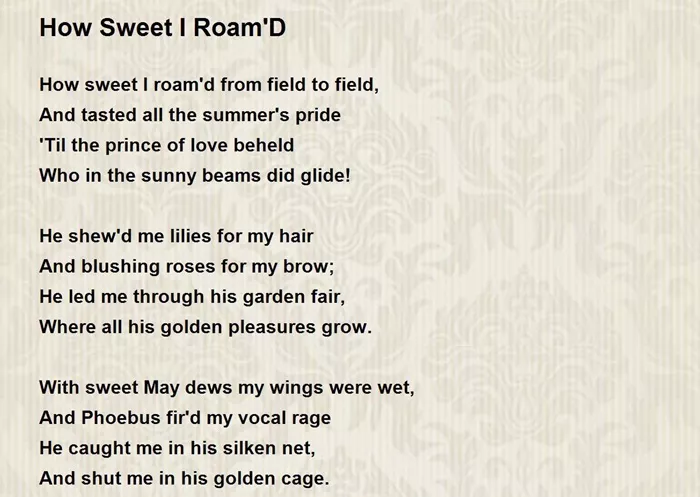Welcome to Poem of the Day – How Sweet I Roam’d by William Blake
William Blake, an iconic figure in English literature, is renowned for his deeply spiritual and visionary poetry. One of his poems, “How Sweet I Roam’d,” captures the essence of innocence, nature, and the purity of a child’s vision. This short but profound poem belongs to his collection titled Songs of Innocence, first published in 1789. The poem explores the themes of innocence, freedom, and the connection between the individual and nature. In this article, we will analyze and explain the key aspects of the poem, helping readers understand its meaning and significance.
How Sweet I Roam’d Explanation
Summary of “How Sweet I Roam’d”
In “How Sweet I Roam’d,” Blake expresses the joy and freedom he feels while walking through nature. The speaker describes the beauty of the world, particularly through the imagery of roaming around and enjoying the natural environment. However, as the poem progresses, the speaker encounters a sense of loss and longing, symbolized by the figure of a child who is “lost” in the world. The poem shifts from celebration to reflection, highlighting the contrast between the innocence of childhood and the complexities of adult life.
Theme of Innocence
The central theme of the poem is innocence. This theme is common in Blake’s Songs of Innocence collection, where he contrasts the purity of childhood with the corruption and loss of innocence that often accompany adulthood. In the first lines, the speaker refers to the joy of roaming freely through nature, a symbol of the innocent spirit. The “sweetness” mentioned suggests a carefree and simple existence, free from the burdens of responsibility and the constraints of society.
Nature as a Source of Innocence
Blake often uses nature as a mirror for the soul, representing a pure and untainted vision of the world. In this poem, nature becomes the setting for the speaker’s innocence. The imagery of roaming in the countryside, surrounded by flowers, birds, and green fields, symbolizes a return to a natural state of being—unaffected by the harsh realities of the adult world. Through this connection to nature, Blake suggests that innocence is found in the simplest and most natural elements of life.
Loss of Innocence
As the poem progresses, Blake shifts from the celebration of innocence to a more somber reflection on its loss. The imagery of the child “lost” suggests that innocence is not easily preserved and can be taken away or forgotten. This loss of innocence is a key theme in Blake’s works, particularly in the Songs of Experience, a companion collection to Songs of Innocence. In contrast to the simplicity and purity of childhood, adulthood often brings challenges and a loss of that original joy and vision. The speaker’s acknowledgment of the lost child serves as a poignant reminder of this transition.
Conclusion
In “How Sweet I Roam’d,” William Blake uses simple, yet evocative language to explore the delicate balance between innocence and experience. Through the imagery of nature and the metaphor of the lost child, Blake delves into the universal theme of innocence’s fragility. The poem is a gentle reminder of the purity of childhood and the inevitable journey from innocence to experience. Its simplicity is part of its strength, as it captures deep emotions and profound insights in just a few short lines. For readers, this poem offers an invitation to reflect on their own connection to nature, innocence, and the passage of time.

